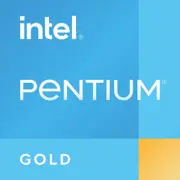Intel Pentium Gold G6505

Intel Pentium Gold G6505: Budget Processor for Basic Tasks
April 2025
1. Key Features: Architecture and Performance
Code Name and Process Technology
The Intel Pentium Gold G6505 belongs to the Comet Lake family (10th generation) and is manufactured using a 14nm process technology. Despite 14nm being an outdated technology (with 7nm and 5nm chips dominating in 2025), Intel continues to support such solutions for the budget segment. This is a dual-core processor with Hyper-Threading support, providing 4 threads. The base frequency is 4.1 GHz, with no Turbo Boost.
Key Features
- L3 Cache: 4 MB — sufficient for simple applications, but limited for complex computations.
- Integrated Graphics: Intel UHD Graphics 630 with a base frequency of 350 MHz and dynamic boost up to 1.1 GHz. Supports 4K@60Hz via HDMI 1.4 or DisplayPort.
- Power Consumption: TDP of 58W — this processor does not require robust cooling solutions.
Performance
In Cinebench R23 tests, the G6505 scores around 2200 points in multi-threaded mode. For comparison, modern 4-core processors (like the Core i3-12100) yield scores above 6000 points. However, for office tasks, web browsing, and streaming video, this performance is adequate.
2. Compatible Motherboards
Socket and Chipsets
The processor uses the LGA 1200 socket. Compatible chipsets include:
- H410/B460: Budget boards with basic functionality (up to 64 GB DDR4-2666, PCIe 3.0).
- H470/Z490: Advanced options supporting PCIe 3.0/4.0 and USB 3.2 Gen 2.
Example Boards
- ASRock H410M-HDV ($65–75): Minimal ports, but stable operation.
- Gigabyte B460M DS3H ($90–100): Two M.2 slots and 4 RAM slots.
Important! Update the BIOS before installation — some boards require patches for Comet Lake.
3. Supported Memory
The Pentium G6505 supports DDR4-2666 (officially). Motherboards based on H410/B460 may limit speed to 2400 MHz. DDR5 is not supported.
Memory Recommendations
- 8 GB (2x4 GB): Minimum for Windows 11 and browsing.
- 16 GB (2x8 GB): Comfortable multitasking with multiple tabs and light applications.
Example Module: Patriot Signature Line DDR4-2666 8 GB — $25 each.
4. Power Supplies: Calculation and Recommendations
With a TDP of 58W and integrated graphics, a system with the G6505 consumes about 120–150W under load (including SSD, fans, and peripherals).
Optimal PSU:
- Power: 400–500W (e.g., EVGA 500 W1 — $45).
- Certification: 80+ Bronze or higher for reliability.
Tip: Don’t skimp on the PSU — cheap models (like Apevia) can damage components.
5. Pros and Cons
Advantages:
- Low price ($75–85 in 2025).
- Energy efficiency (suitable for compact builds).
- Integrated graphics for operation without a dedicated GPU.
Disadvantages:
- Only 2 cores — multitasking is limited.
- Outdated 14nm process technology.
- No support for PCIe 4.0 and DDR5.
6. Use Cases
Office and Study
Ideal for Word, Excel, Zoom, and browsers with 10–15 tabs open.
Multimedia
Streaming 4K video (Netflix, YouTube) without lag.
Gaming
Only light titles:
- Minecraft (60 FPS on medium settings).
- CS:GO (720p, low settings, ~40–50 FPS).
- Older games via emulators (e.g., PS2 games).
What to Avoid: Video editing, 3D rendering, modern AAA games.
7. Comparison with Competitors
AMD Athlon 3000G (Zen, 2 cores/4 threads, $60)
- Pros: Better graphics (Vega 3), unlocked multiplier.
- Cons: Low frequency (3.5 GHz), outdated AM4 platform.
Intel Celeron G5925 (2 cores/2 threads, $55)
- Pros: Cheaper.
- Cons: No Hyper-Threading — multi-threaded performance is 30% lower.
Conclusion: The G6505 is the sweet spot between price and functionality.
8. Building Tips
1. Motherboard: Choose models with HDMI/DisplayPort if you don’t plan to use a discrete graphics card.
2. Cooling: The boxed cooler will suffice — even under load, temperatures will not exceed 65°C.
3. Storage: Use an SSD (e.g., Kingston A400 240GB — $30) for fast OS boot-up.
4. Case: Mini-ITX (Fractal Design Core 500) for a compact media center.
9. Final Verdict: Who is the G6505 for?
This processor is a choice for:
- Budget PCs: Build for $250–300 (without a graphics card).
- Office Workstations: Reliability and minimal power consumption.
- Home Media Centers: Connecting to a TV for streaming.
Why you might want to avoid it: If you plan to play new releases or work in Photoshop/Blender, even the Core i3-13100 ($120) will be 3 times faster.
Price in 2025:
- Intel Pentium Gold G6505: $75–85 (new).
- AMD Athlon 3000G: $60–70 (new).
Summary: The G6505 is a modest yet reliable chip for undemanding tasks. Its main advantages are the price and minimal system requirements.
Basic
CPU Specifications
Memory Specifications
GPU Specifications
Miscellaneous
Benchmarks
Compared to Other CPU
Share in social media
Or Link To Us
<a href="https://cputronic.com/en/cpu/intel-pentium-gold-g6505" target="_blank">Intel Pentium Gold G6505</a>